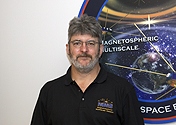MMS and Space Weather Geek Out
Carl and Richard got the amazing opportunity to go to the NASA Goddard Space Flight center to see the James Web Space Telescope in person. And while there, they sat down with Craig Tooley, the Project Manager of the Magnetospheric Multiscale Mission (MMS) to understand a bit more about space weather and the remarkable science and engineering that goes into a mission like MMS. The MMS mission utilizes four identical spacecraft flying in formation to measure plasma interaction effects between the Earth's magnetosphere and the sun. The goal of MMS to capture (by flying through) a magnetic reconnection event, where a huge amount of plasma energy is discharged. As with most things in the universe, reality is a complex thing, and the MMS is at the forefront of our understanding of the universe, at least around our planet!
Guests:

Craig Tooley
Mr. Tooley is currently the project manager for NASA's Magnetospheric Multiscale (MMS) mission. MMS is an in-house GSFC mission launching in March of 2015, which will use four identical spacecraft, flown in formation in Earth orbit, to make three-dimensional measurements of the plasma in the magnetospheric boundary regions and investigate the fundamental energy transfer process of magnetic reconnection. Mr. Tooley joined the MMS Team as Project Manager in May 2011. Prior to being assigned as the MMS project manager Mr. Tooley was NASA's project manager for the Joint Polar Satellite System (JPSS) Flight Project. The JPSS Flight Project is responsible for providing the nation's next generation of polar orbiting weather and climate science satellites in partnership with the National Oceanic and Atmospheric Administration (NOAA). Before joining JPSS Mr. Tooley was the project manager for the Lunar Reconnaissance Orbiter (LRO) mission at NASA's Goddard Space Flight Center (GSFC). He was responsible for the development and execution of the LRO mission for NASA's Exploration Systems Mission Directorate (ESMD). LRO was developed in-house at NASA's Goddard Space Flight Center, was launched on June 18th, 2009, and is successfully operating in lunar orbit. Previously, Mr. Tooley was the Head of the Hubble Space Telescope (HST) Instrument Development Office at GSFC. In this capacity oversaw the development of instruments that were installed in the HST during the 4th HST servicing Mission. During his tenure in the HST Project Mr. Tooley also worked as part of the EVA Servicing Team, which developed procedures and trained astronauts for the successful SM3B servicing mission in 2002. Prior to working in the HST Project Mr. Tooley served as the Deputy Project Manager for the Triana Project. Triana was a Space Shuttle launched earth science mission which was to provide continuous global observation from a libration point (L1). Mr. Tooley also directly lead the engineering development of the upper stage and Space Shuttle Airborne Support Equipment required for the Triana mission. Triana (now renamed DSCOVR) was built and fully qualified at GSFC but has not yet been launched. During his career at GSFC Mr. Tooley has served as the Mission Manager and Mechanical Engineering Lead for 5 successful Shuttle borne, solar science Spartan missions and held the position of Associate Branch Head of the Carrier Systems Branch. During the first part of his career he worked as an engineer the Mechanical, Attitude Control and Stabilization, and the Mission Analysis groups at GSFC. Mr. Tooley has been employed by NASA since 1983 and has a background in Mechanical Engineering. He earned a BS in Mechanical Engineering from the University of Evansville and a MS in Mechanical Engineering from the University of Maryland. He holds a Senior-Expert level of Project Management certification at NASA.
Links:
- Flic http://flic.io/#/
- Magnetospheric Multiscale Mission http://mms.gsfc.nasa.gov/
